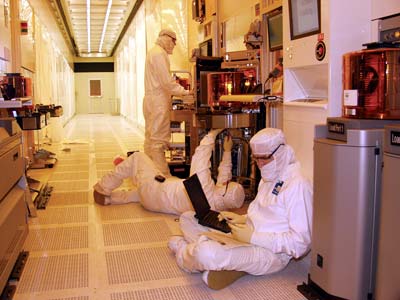COVER STORY
Knowledge Multipliers
The 300-mm. standard that will soon be in action at seven Intel fabs worldwide is known for the pronounced increase in production capacity if affords the company. How Intel works internally and externally to cultivate expertise is at least as important in the way it increases knowledge and innovation capacity.
Asked how the company's internationally overlapped site selection teams share best practices, Leising says, "Our site selection and development process is managed internally by a small team in corporate real estate and is supplemented by functional experts from areas like human resources, tax, environmental, logistics, utilities, security, public affairs, legal and so on. The site selection team is responsible for ensuring that best practices are captured and implemented. The functional experts are also continually looking to improve the analysis that they do and search for best known methods, or BKMs, to help their evaluations. We also benchmark other companies and consultants to ensure we have a best-in-class process."
 |
| Intel's Fab 32 in Chandler, Ariz., will mean the hiring of 1,000 more highly skilled personnel. Intel cultivates talent with both internal training and community outreach efforts like "Teach to the Future," which in January 2006 announced it would expand to reach 10 million teachers in developing nations, after training some 3 million since 2000. |
Looking outside, Leising says the company always focuses a large percentage of community investment in science, math, engineering and technology programs, delivering programs like "Teach to the Future," which provides teachers with skills. That program in January 2006 announced it would expand to reach 10 million teachers in developing nations, after training some 3 million since 2000. The company's Computer Clubhouses work in parallel by bringing technology and curriculum to underserved communities.
When it comes to work force training, Leising says, "We will adapt our programs to meet the need of the individual location — each site is a little different." Kiryat Gat is a case in point, and also shows how far down companies are drilling to cultivate the knowledge resources they know they're going to need.
"In Fab 18 we have a unique training program called 'Ofek,' implemented in conjunction with the Ministry of Industry and Trade and the Employment Service, which enables job seekers from the south to join the company's manufacturing lines. The course has been given seven times and about 180 of its graduates have been absorbed by Intel. Second, Intel cooperates with the Kiryat Gat education system and operates a variety of special science courses for the fifth and sixth grade pupils from about 25 local schools. In those programs, kids learn and experience an advanced level of science studies. The courses are delivered by 50 university and college science and engineering students who receive scholarships from Intel. This unique program was adopted and expanded to other parts of the country."
As all of Intel's projects unfold, so do its processes. After all, other companies from Samsung to Texas Instruments to Micron have their own mega-projects. In fact, one of Micron's projects is a global site search currently under way for a joint venture NAND chip plant it will operate along with Intel.
In parallel, the territories in which Intel operates are fabricating their own tools to keep them there: In May 2005, local county and city officials in Oregon, where 15,500 people work on seven different Intel campuses, approved property tax exemptions on Intel property in the state that amounted to a value of $25 billion.
According to an October 2004 report from the Center for Business Research at Arizona State University, Intel's current presence in Arizona has a $2.6 billion annual impact on the state's economy and supports 27,680 indirect Arizona jobs. Among the impact's components are approximately $50 million in taxes still paid each year by the company, $87.5 million in employee taxes and $276 million in goods and services purchased from Arizona-based businesses.
An updated preliminary site development plan put before the Arizona community in April 2005 included the possibility — in addition to Fab 32 — of yet another fab along the west side of the company's property in Chandler.
Will that project and others come to fruition in the U.S.? What ensues in the nation's capital and in classrooms across the nation may help answer that question.
"The people here in this part of the world understand that when you have a research and development facility that promotes modern technology, it improves the quality of the life of the community in which the facility exists," said Pres. Bush during a February 2006 panel discussion held at Intel's Rio Rancho complex. And that has been, really, Craig Barrett's credo as the CEO of this company. He wants to provide a product that people want to buy, obviously … but he also understands … something called corporate responsibility. It's in his interest that there be corporate responsibility in Intel. In other words, Intel can only be strong if it has a work force that's capable of making sure this company is competitive in a global economy.
"We want to get 30,000 adjunct professors into classrooms — that's a fancy word for saying we want engineers and chemists and physicists in places like Intel, or retired professionals, to go in the classroom and excite students about the possibility of math and science" the president continued. "We need people walking into a classroom full of youngsters and saying, 'You're not going to believe how cool this profession is. You're not going to believe the horizons that will be available to you.' And one of the things Craig has encouraged Intel to do is do just that."
"Discovery, ingenuity and innovation have always been at the forefront of U.S. economic and technological leadership," says Leising. "Intel is concerned that the U.S. is losing its competitiveness edge."

